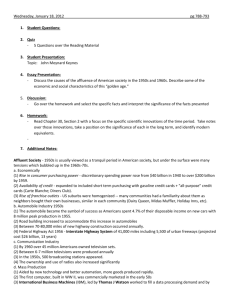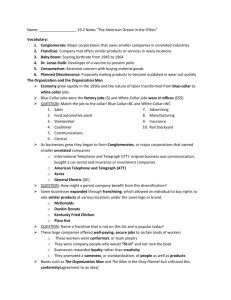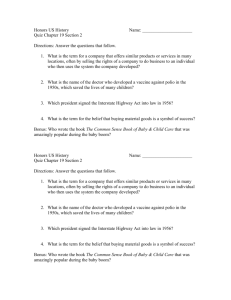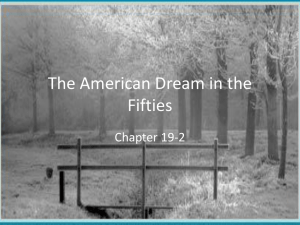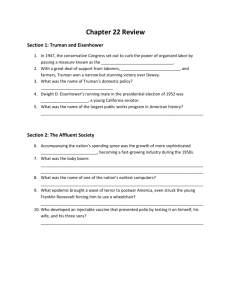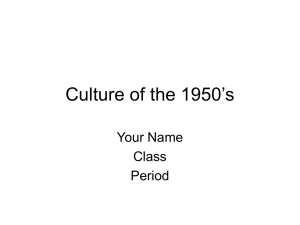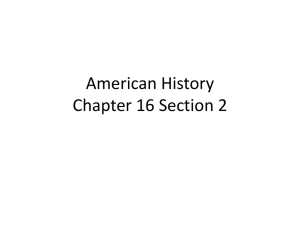1950s Society
advertisement
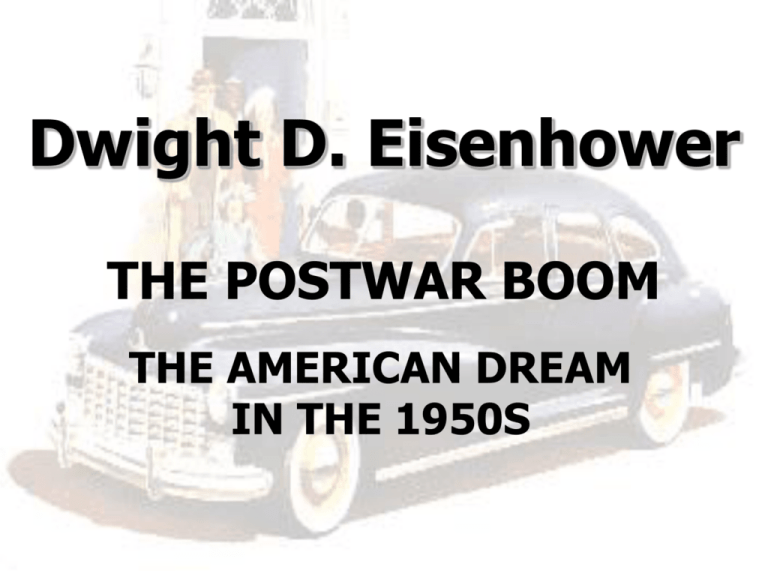
Dwight D. Eisenhower THE POSTWAR BOOM THE AMERICAN DREAM IN THE 1950S 1950s Economy a. Post-war spending trends continued into the 1950s b. Americans invested in items based around the home and family life c. The American consumer was praised as a patriotic citizen – one who contributed to the overall success of the American way of life Consumerism Westinghouse Refrigerator Example of 1950s Consumerism d. Defense spending accounted for half of the federal budget e. Nation’s first nuclear power plant opened in 1957 – the chemical and electronics industry boomed f. Beneath this widespread prosperity, poverty was becoming more prevalent and the gap between rich and poor widened (more than 1/5 lived below the poverty line) THE SUBURBAN LIFESTYLE a. After WWII, returning vets faced a severe housing shortage b. In response to the crisis, developers used assemblyline methods to massproduce houses c. Developer William Levitt bragged that his company could build a home in 16 minutes for $7,000 d. Suburbs were born With the help of the GI Bill, many veterans moved into suburbs THE SUBURBAN LIFESTYLE The American Dream complete with a white picket fence e. Most Americans worked in cities, but fewer and fewer of them lived there f. New highways and the affordability of cars and gasoline made commuting possible g. Of the 13 million homes built in the 1950s, 85% were built in suburbs h. For many, the suburbs were the American Dream Big Business and Labor Unions a. Big business flourished in the 1950s – less than .05% of American corporations controlled more than half of the nation’s corporate wealth b. Advances in science and technology decreased the amount of labor necessary for industry and agriculture to be financially successful which led to consolidation of industry and agriculture into large corporations c. Unions consolidated as well – AFL and CIO merged in 1955 d. Prosperity meant high wages and few labor complaints – depriving unions of the needed membership Affluent Society a. Term coined by John Kenneth Galbraith in The Affluent Society (1958) b. Ironic term that described the 1950s U.S. as rich in the private resources but poor in public ones because of misplaced priority on increasing production of trivial consumer goods John Kenneth Galbraith c. Galbraith argued the U.S. should shift resources to improve schools, the infrastructure, and social services d. Galbraith will influence social reform efforts of the 1960s e. The term Affluent Society has lost its original ironic meaning – today it is used to indicate widespread prosperity Baby Boom and the Overall Impact a. Prosperity led Americans to start families earlier and have more children b. Birth rate grew steadily from 1950 to its peak in 1957 c. U.S. population grew from 150 million to about 180 million during the 1950s d. Baby boomers represent the largest generation in the nation’s history What are the official years of the Baby Boom Generation? 1946 - 1964 saw a marked increase in the number How did the birthrate rise and fall during the baby boom years in the US? 1940 2,559,000 births per year 1946 3,311,000 births per year 1955 4,097,000 births per year 1957 4,300,000 births per year 1964 4,027,000 births per year of births in North America. 1957 1 baby born every 7 seconds 1974 3,160,000 births per year It seems to me that every other young housewife I see is pregnant. -- British visitor to America, 1958 WHAT IT WILL MEAN TO YOU Your generation will be supporting an increasingly aging American population WHY SO MANY BABIES? Why did the baby boom occur when it did? a. Husbands returning from war b. Decreasing marriage age c. Desirability of large families d. Confidence in economy e. Advances in medicine ADVANCES IN MEDICINE AND CHILDCARE a. Advances in the treatment of childhood diseases included drugs to combat typhoid fever and polio (Jonas Salk) Dr. Salk was instrumental in the eradication of polio DR. SPOCK ADVISES PARENTS Dr. Spock’s book sold 10 million copies in the 1950s a. Many parents raised their children according to the guidelines of pediatrician Dr. Benjamin Spock b. He thought children should be allowed to express themselves and parents should never physically punish their kids c. Dr. Benjamin Spock author of Baby and Child Care (1946) suggested mothers devote themselves to the fulltime care of their children Baby Boom Dr. Benjamin Spock and the Anderson Quintuplets d. Popular culture depicted marriage and taking care of the family as the primary goal of the American woman e. Religious messages began to merge into popular culture – during the 1950s Congress added “under God” to the Pledge of Allegiance (due to the fight against communism) Fads of the Baby Boomers Hula Hoops Frozen Foods Poodle Skirts and Saddle Shoes What celebrity deaths have most affected the Baby Boomers? Panty Raids John F. Kennedy Barbie and GI Joe Dolls Bikinis Marilyn Monroe Frisbees Martin Luther King Yo-yos John Lennon Ouija Boards Dune Buggies Consumer Culture - Television a. TV dominated American culture during the 1950s – only 6 TV stations broadcast in 1946 and by 1956, 442 stations were operating b. 7 million TV sets were sold in 1951 c. TV portrayed a cookie-cutter stereotyped image of happy, prosperous Americans POPULAR CULTURE d. A new era of mass media led by television emerged in the 1950s e. In 1948, only 9% of homes had T.V f. In 1950, 55% of homes had T.V. g. By 1960, 90% of American homes had T.V. h. TV brought messages of conformity and consumerism i. TV produced fads for the hula hoop and Davy Crockett’s coonskin cap Despite their success, some workers questioned whether pursuing the American dream exacted too high a price, as conformity replaced individuality THE GOLDEN AGE OF TELEVISION J. The 1950s was known as the “Golden Age of Television” k. Comedies were the main attraction as Milton Berle, Lucille Ball and Desi Arnaz were very popular Desi Arnaz and Lucille Ball starred in I Love Lucy TELEVISION EXPERIMENTS WITH VARIOUS FORMATS l. Television innovations like on-the-scenenews reporting, interviews, westerns and sporting events offered the viewer a variety of shows m. Kids’ shows like The Howdy Doody Show and The Mickey Mouse Club were extremely popular TV ADS, TV GUIDES AND TV DINNERS EXPAND n. TV advertising soared from $170 million in 1950 to nearly $2 billion in 1960 o. TV Guide magazine quickly became the best selling magazine p. Frozen TV dinners were introduced in 1954 – these complete ready-to-heat meals on disposable aluminum trays made it easy for people to eat without missing their favorite shows A SUBCULTURE EMERGES a. Although mass media and television were wildly popular in the 1950s, dissenting voices emerged b. The “Beat Movement” in literature and rock n’ roll clashed with tidy suburban views of life BEATNIKS FOLLOW OWN PATH Beatniks often performed poetry or music in coffeehouses or bars c. Centered in San Francisco, L.A. and New York’s Greenwich Village, the Beat Movement expressed social nonconformity d. Followers, called “beatniks”, tended to shun work and sought understanding through Zen Buddhism, music, and sometimes drugs MUSIC IN THE 1950s a. Musicians in the 1950s added electronic instruments to traditional blues music, creating rhythm and blues b. Cleveland DJ Alan Freed was the first to play this music in 1951– he called it “rock and roll” FREED ROCK N’ ROLL c. In the early and mid-fifties, Richard Penniman, Chuck Berry, Bill Haley and the Comets, and especially Elvis Presley brought rock and roll to the forefront d. The driving rhythm and lyrics featuring love, cars, and problems of being young --captivated teenagers across the country THE KING OF ROCK AND ROLL e. Elvis Presley’s rebellious style captured young audiences f. Girls screamed and fainted, and boys tried to imitate him Consumer Culture -Rock-nRoll g. Elvis Presley epitomized rock-n-roll of the 1950s h. Born in Tupelo, MS in 1935 i. Presley produced 14 consecutive records between 1956 and 1958 – each sold over a million copies THE AUTOMOBILE CULTURE a. After the rationing of WWII, inexpensive and plentiful fuel and easy credit led many to buy cars b. By 1960, over 60 million Americans owned autos INTERSTATE HIGHWAY ACT 1956 a. In 1956 Ike authorized a nationwide highway network – 41,000 miles of road linking America THE INTERSTATE HIGHWAY SYSTEM b. “Automania” spurred the construction of roads linking major cities while connecting schools, shopping centers and workplaces to residential suburbs IMPACT OF THE HIGHWAY Trucking is the #1 means of moving cargo in the United States today c. The Interstate Highway system resulted in: 1. More trucking 2. Less railroad 3. More suburbs, further away HIGHWAYS “HOMOGENIZE” AMERICA d. Another effect of the highway system was that the scenery of America began to look the same e. Restaurants, motels, highway billboards, gas stations, etc. all began to look similar f. The nation had become “homogenized” Anytown, USA “Our new roads, with their ancillaries, the motels, filling stations, and restaurants advertising eats, have made it possible for you to drive from Brooklyn to Los Angeles without a change of diet, scenery, or culture.” John Keats, The Insolent Chariots 1958 Duck and Cover a. Fears of nuclear attacks from the Soviets prompted a new social phenomenon b. Americans began building bomb shelters or fallout shelters c. U.S. Government produced Duck and Cover (1951) as a public awareness campaign to illustrate that nuclear attacks could occur at anytime d. School children helped in making the project – the cartoon character “Bert the Turtle” was used as the subject of practicing duck and cover tactics

